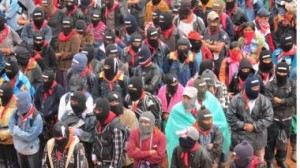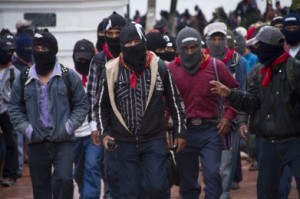 Imagine close to 50,000 people marching in absolute silence, in five different townships, from two to five hours apart. Not a word, nor even a greeting. Just a raised fist in a sign of strength, determination and unity. Streets overflowing with masked faces and wordlessness. It is a huge demonstration of force–the largest in the entire history of the Zapatista movement–just days before the 19th anniversary of their first public appearance and 30 years since their founding.
Imagine close to 50,000 people marching in absolute silence, in five different townships, from two to five hours apart. Not a word, nor even a greeting. Just a raised fist in a sign of strength, determination and unity. Streets overflowing with masked faces and wordlessness. It is a huge demonstration of force–the largest in the entire history of the Zapatista movement–just days before the 19th anniversary of their first public appearance and 30 years since their founding.
What’s behind a mass mobilization like this, with no more resources than what the communities themselves can offer? Without the spending accounts of political parties or other organizations that only mobilize with government money?
The Zapatista Army of National Liberation (EZLN, by its Spanish initials) has taken a stance again. It wasn’t a surprise like the first dawn of 1994, since the Dec. 21, 2012 reappearance had been announced beforehand. But no one knew it would be in silence and with greater strength than two decades ago. Twenty years ago no one imagined the EZLN even existed and although the state had enough information to predict the attack, it preferred to wait to act to avoid dampening the parade of its entrance into the First World with NAFTA. Those days of January 1994, the government immediately ordered military operations, but it had already been surprised, along with the rest of the world. The same thing happened 19 years later, this time without arms.
With the federal army deployed throughout the territory with the pretext of the war on drugs, Chiapas is the most militarized state in the country. In a show of defiance, the Zapatistas retake the streets and the two flags that they have always flown—the EZLN flag and the Mexican flag—wave freely. They carried these two flags in 1994, they have walked with them throughout the years, they always bear them. They earned the right to traverse the country with their message of rebellion, with an army that backs them up, from the first twelve days of combat. No one can deny then that right.
Five presidents have ignored their demands. All have wanted to annihilate them, by bullets or with expensive government counterinsurgency programs. Slander and smear campaigns have surrounded them. The last year has seen a flurry of rumors of the death or illness of the spokesperson and military chief, subcomandante Marcos, who now has proved alive and well, like the tens of thousands of indigenous people of the organization who make up the backbone of the movement.
The silence of the march and the brief communiqué afterward revived expectations. What’s next? When? Not only those from below are asking, Enrique Peña Nieto must also be wondering, along with the many-colored and many-faceted powers that be, since it is clear that even though they avoid speaking their name and pretend that therefore they don’t exist, the demonstration of Dec. 21 is only the beginning. They’re there, and they’re legion. They are rebels. No one can buy them off. They are not divided. Their spokesperson is still their spokesperson. They are coming.
They surprised Carlos Salinas de Gortari in 1994, in the middle of his New Year dinner and what was not only the end of his administration, but also, and for the elite, the beginning of a new era–one that was not supposed to include an insurrection from below. A declaration of war and the military takeover of seven municipal seats by an indigenous army was Salinas’ send-off.
Ernesto Zedillo was greeted in office with the message: “Welcome to the nightmare”. This was followed by a position that has remain unchanged since then: “You should disappear, not only because you represent a historic relation, a historic aberration, a negation of humanity, and a cynical cruelty; you should disappear also because you represent an insult to the intelligence. You made us possible; you made us grow. We are your other, your Siamese opposite. To get rid of us, you must disappear.” The Zapatistas began the Zedillo administration with the Third Declaration of the Lacandon Jungle, in which they proposed the creation of a Movement for National Liberation.
 The third presidency the Zapatistas experienced was headed by Vicente Fox Quezada, of the National Action Party (PAN), who broke with more than 70 years of PRI hegemony. They told Fox from the first day of his government: “There should be no doubt. We are your opponents.” With this message one of the most important mobilizations of the Zapatista movement began—the March the Color of the Earth.
The third presidency the Zapatistas experienced was headed by Vicente Fox Quezada, of the National Action Party (PAN), who broke with more than 70 years of PRI hegemony. They told Fox from the first day of his government: “There should be no doubt. We are your opponents.” With this message one of the most important mobilizations of the Zapatista movement began—the March the Color of the Earth.
The re-election of the PAN to the federal government with Felipe Calderón Hinojosa at the helm was the next time the EZLN saw a change in government. This was also the launching of the Other Campaign, announced the first day of 2006: “We are going to begin to walk to keep our promise made in the Sixth Declaration of the Lacandon Jungle. I will be the first to come out,” said Subcomandante Marcos, “to see what the path we will be walking is like and if there are dangers, and to learn to recognize the face and the word of our fellow travelers. To unite the Zapatista struggle with the struggle of workers in the cities and countryside of our country called Mexico.”
Today, five administrations later–with the important construction of autonomy in their villages, after many encounters and dis-encounters, with more than a few pains–the first message to the return of the PRI, and especially and as always to the people, is absolutely clear: “We are here.”
Gloria Muñoz Ramírez is the director of Desinformémonos, www.desinformemonos.org, where this article was first published in Spanish and a contributor to the CIP Americas Program at www.americas.org.
Translation: Laura Carlsen Photos: Tim Russo, Leonidas Oikonomakis
For More Information:
Series of articles on indigenous autonomy in the Zapatista communities of Chiapas, by Gloria Muñoz Ramírez.
Caracol #1: La Realidad, https://www.americas.org/archives/1609
Caracol #2: Oventic, https://www.americas.org/archives/1610
Caracol#3: La Garrucha, https://www.americas.org/archives/1597
Caracol #4: Morelia, https://www.americas.org/archives/1604
Caracol #5: Roberto Barrios, https://www.americas.org/archives/1593



